XMT 350, Jetline Controller Help Wheel Manufacturer Eliminate Spatter
Don’t re-invent the wheel, just the process to weld one
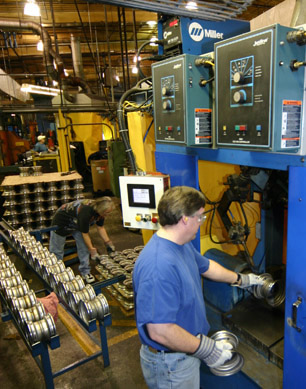 |
|
Fig. 1 - XMT 350 CC/CV inverters from Miller and CSC MIG weld process controllers from Jetline helped Carlisle address issues related to spatter and improve quality.
|
To meet the cosmetic demands of its customers, Carlisle Tire & Wheel Company strives to eliminate weld spatter from its finished products. However, the short circuit MIG process with conventional MIG systems inherently produces spatter. To address this issue, Carlisle previously did what tens of thousands of other world-class, high volume fabricators do: bought anti-spatter solution by the “tanker load” and ran parts through an anti-spatter tank immediately prior to welding. As a post-weld quality assurance measure, Carlisle dedicated one full-time employee to staff a repair booth eight to 10 hours a day.
To address issues related to spatter and improve quality, Carlisle’s Slinger, Wis. facility recently upgraded its welding cells and installed new systems that consist of XMT® 350 CC/CV inverters from Miller, CSC™ MIG weld process controllers from Jetline Engineering (see Fig. 1) and BR6 copper-coated filler wire in Recyclable ROBOPAK containers from Hobart Brothers.
As the leading manufacturer and distributor of quality commercial, recreational, utility tires and wheels, Carlisle is dedicated to continuous improvement.
“It’s always been our goal to produce the highest quality product at the lowest cost,” says Richard Kohl, operations manager for Carlisle’s Slinger facility. “Enhancing our welding process to increase our competitiveness is just one small example of the Carlisle continuous improvement philosophy.”
As part of changing a welding process that had been in place for 36 years, Carlisle coordinated an internal team consisting of management, engineering, floor supervisors and plant workers. Through their hard work, plus support from Miller welding engineer Joe Fink and Miller district manager Kevan Kokkonen, Carlisle reinvented wheel manufacturing, eliminated spatter and increased quality.
The Problems with Spatter
Carlisle fabricates its wheels from low carbon steel. Plate for the 6-in. wheel is thin gauge, and the hub tube ranges from 1/16- to 1/4-in. thick. A hydraulic press pushes the hub through the center hole in the wheel plate, and then a two-torch, automatic system welds the hub to the wheel. However, the anti-spatter solution applied just before welding created a sticky mess.
“Anti-spatter covered the welding cell (see Fig. 2), clogged the MIG gun nozzles and even got inside the rectifiers (welder),” says Doug Karlin, Carlisle production engineer. “Of course, you have to wash off the anti-spatter, and it dirtied up the wash tanks. And each day, a set-up person cleaned the anti-spatter tanks and refilled them with the anti-spatter solution. If the solution was not mixed correctly, even with frequent cleaning, the application nozzles would clog up.”
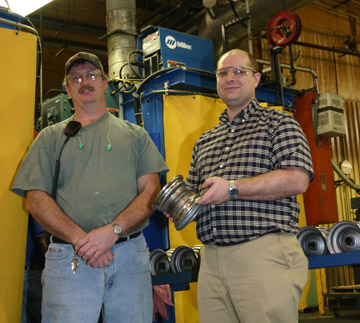 |
|
Dale Scherr, lead person, first shift (left), and production engineer Doug Karlin were just two of the Carlisle team members that helped enhance Carlisle's welding process.
|
This mess was a mere annoyance compared to the real problem: the cost of maintaining quality.
“Trying to weld through a liquid is not an easy or smart thing to do,” says Karlin. “We often had too much or not enough anti-spatter solution. With too little, spatter would stick to the wheels. With too much, pinholes would form in the weld, which would then have to be repaired. The pinholes also caused problems with painting.”
“If we didn’t catch a pinhole problem, we then had to remove the paint and repair the weld,” says quality/engineering supervisor Harlan Janssen.
Unique Welding System Eliminates Spatter
Carlisle needed a welding process that eliminated spatter, provided 100 percent penetration, yet wasn’t so hot that it caused burn through or distortion. The spray transfer MIG process was too hot, and because of an earlier experience with older pulsed MIG technology, Carlisle management knew the employees wouldn’t accept it.
Through its relationship with sister company Jetline, Miller representatives knew that the CSC MIG weld process controller paired with an XMT 350 CC/CV inverter could provide a solution.
CSC stands for controlled short circuit, and Jetline developed it specifically to eliminate spatter and increase travel speed on thin materials. The process produces TIG-quality welds at MIG travel speeds. With the CSC process, a high speed, high precision stepper motor controls the feeding direction and speed of the electrode and coordinates it with the amperage delivered by the welding power source. Simply stated, it moves the wire in and out of the weld puddle to control the short circuiting process in a manner that eliminates the explosive “flaming batons” of filler wire that create spatter in traditional short circuit MIG (see side bar story below for more technical information).
Carlisle selected the XMT 350 over other inverters because it features Miller’s exclusive Auto-Line™ power management technology.
“Carlisle gets a ‘big bang’ out of the XMT 350 because of its duty cycl (350 amps at 60 percent) and because Auto-Line makes problems a thing of the past,” says Miller’s Kevan Kokkonen.
Auto-Line also makes the XMT 350 inverter very power efficient, so it uses less primary power than conventional MIG welders.
“The XMT 350 is 28 percent more power-efficient, which amounts to energy savings of $1,000 a year,” says Karlin. “It’s small, but it was still a savings that we were able to get back.”
Travel Speed Increases 25 Percent
Once implemented on Carlisle’s 6-in. wheel production line, the new process completely eliminated the use of anti-spatter (see Fig. 3), as well as eliminated all but the rarest instances of spatter. As a result of eliminating spatter, Carlisle now uses less .062-in. wire to weld a 1.5-in. diameter hub.
Fig. 2
 |
Fig. 3
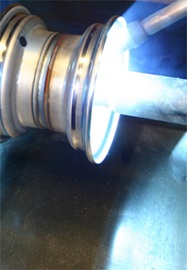 |
| With conventional short circut MIG, anti-spatter solution covered the welding cell. The XMT 350/CSC system eliminated the use of anti-spatter solution and cleaned up the welding cell. |
The XMT/CSC combination produced such consistent weld quality that it not only eliminated pinholes and subsequent quality problems. “We can apply enough pressure to deform the hub and crush it like a soda can and even then, the weld won’t break,” says Harlan. “When it does tear, it tears about 1/4-in. away from the weld, so we know the weld has a stronger tensile strength than the parent material. This is attributed to the minimal heat-affected zone of the CSC process.”
Welding parameters did not change much between the old and the new system, just the control of the process. Today, weld parameters range from 15 to 17 volts, 135 to 150 amps and 40 cubic feet/hour of shielding gas. The CSC controller locks weld parameters, guaranteeing consistency between all three shifts. A gas flow regulator with a fixed orifice on a bulk gas system also guarantees consistent gas coverage.
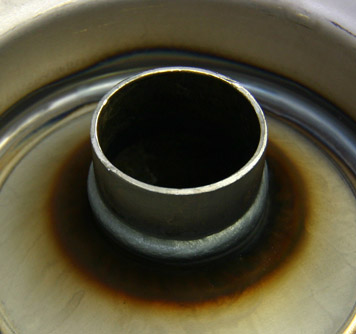 |
|
This photo of the hub/plate weld as it comes off the production line shows how Carlisle eliminated spatter and improved quality.
|
Other Savings
As part of changing to a new welding system, Carlisle also switched its wire packaging system to Hobart Brothers’ Recyclable ROBOPAK after it was introduced to them by Lane Holder and Ken Faulkner of Airstar, Carlisle’s welding supply distributor.
“The ROBOPAK 950 reduced reject rates,” says Harlan. “Previously, we had to apply wire straighteners to remove the cast, which was a problem toward the end of the spool. With the ROBOPAK, the wire is straighter so it makes better contact.” The ROBOPAK, which holds 950 lbs. of wire, also improves organization, saves space and makes it easier to pull wire from inventory (see Fig. 4).
Carlisle also reduced consumable consumption because it switched contact tip brands. “We were using a low-grade tip, thinking that a less expensive tip was going to be a bonus for the price,” says Lehn. “Then we went to Miller’s FasTip, which cost roughly 4 times as much. Now set-up personnel change the tip once a day instead of every hour.”
“On top of that, we calculated the cost for the set-up personnel to change the tip,” Lehn continues. “The cheaper tip is not worth wasting set-up personnel’s time to unscrew, vs. the easy-removing FasTip.”
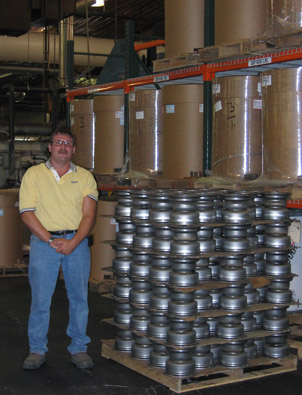 |
|
Fig. 4 - Carlisle welding supervisor Tim Lehn poses with the Hobart Brothers' recyclable ROBOPAK, which helped improve inventory management.
|
To ease into the transition of learning a new process, Miller teamed with Hobart Brothers to provide basic welding and welder maintenance training for employees. Because the CSC process is so different from regular MIG welding, Carlisle wanted the employees to understand the change so they could adapt to it. The challenge was doubly difficult because of the failure of other welding techniques tried in the past.
“When we first introduced the XMT and the CSC, the employees were suspicious of the process and of the change,” says Kohl. “However, we involved them up front. They invested many hours and have now taken ownership of the new equipment (see Fig. 6). In fact, our people took so much pride in the new technology that they powder-painted the doors in Carlisle’s corporate blue color. They said as long as they were going first class, they wanted the plant floor to look good, too.”
For more information on the CSC process, visit www.jetline.com or contact Oscar Santa at osanta@jetline.com
For more information on the Recyclable Robopak, BR-6 and other filler metals, visit www.hobartbrothers.com
[Side bar story]
Superior Short Circuit Control
Jetline’s CSC¾Controlled Short Circuit¾technology produces spatter-free arc ignition, overcoming what many consider the biggest limitation of conventional short circuit MIG. The process has two primary phases, the arc phase and short circuit phase. The system’s control monitors the voltage between the electrode and the work to determine which phase the process is in at any given time. If the voltage is above the “voltage high” threshold setting, the CSC process is in the arc phase. If the voltage is below the “voltage low” threshold setting, the process is in the short circuit phase.
The CSC control adjusts the level of current delivered from the welding power source based on the phase of the process. The arc and short phases are further divided into three segments¾start, mid and final¾based on the amount of current provided. Using different current values for each segment controls the bead shape and size so that end users can tailor the bead profile to match the application.
During the arc phase, heat is generated to melt the base metal and the filler material. The molten droplet is deposited in the short circuit phase when the wire makes contact with the weld puddle.
During the short circuit created by the droplet, the voltage drops below the “voltage low” threshold and the controller starts to retract the wire to clear the short.
The controller sense the short has cleared when the process voltage rises above the “voltage high” threshold, and it retracts the wire to a pre-set arc length. Once the arc length requirements are met, the control feeds the electrode toward to weld puddle and the cycle repeats.